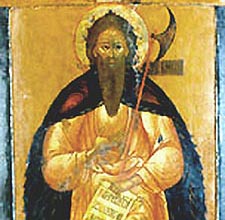Blessed Laurence the Fool-For-Christ at Kaluga

Blessed Laurence, the Fool-for-Christ and Wonderworker of Kaluga, lived at the beginning of the XVI century at a distance of half a verst from old Kaluga, near a forest church dedicated to the Nativity of Christ, set upon a high hill.
There was a long underground entrance from his dwelling place to the church, where he attended services. He also lived at the home of the Kaluga Prince Simeon. It is thought that Blessed Laurence was descended from the noble Khitrov family, since his name is at the head of their memorial at the Peremyshl’sk Liutykov Monastery in the Kaluga diocese.
Blessed Laurence went barefoot both winter and summer, dressed in a shirt and sheepskin coat. By his ascetical struggles he had risen to such heights of virtue that during his lifetime, he was glorified by gifts of grace. He healed many diseases of the eyes through his prayers.
When the Crimean Tatars attacked Kaluga in May 1512, Blessed Laurence, then in the Prince's home, suddenly shouted in a loud voice: “Give me my sharp axe, for the curs are attacking Prince Simeon and I must defend him!” Saying this, he grabbed the axe and left. Suddenly, he was on board a ship next to the Prince. The Holy Fool Laurence inspired and encouraged the soldiers, and at that very hour they defeated the enemy.
Sometimes, he is depicted on icons with an axe in his right hand, set upon a long handle. It is certain that Prince Simeon (+ 1518), who owed his life to Blessed Laurence, built a monastery on the site of the Saint’s ascetical struggles and dedicated it to him.
Blessed Laurence reposed on August 10, 1515, on his Name Day. The Saint is also commemorated on July 8, perhaps in remembrance of his first posthumous miracle in Kaluga in 1621.1
In that year, the paralyzed boyar Lev Andreevich Kologrivov, who could not move his hands and legs, and was unable to speak, was placed near the tomb of Saint Laurence. During a Moleben, as the Gospel was read, the paralyzed man spoke and began to believe. Raising his right hand, he made the Sign of the Cross; then he stood up, went to the tomb and attached himself to it. By the end of the Moleben, he was able to speak normally, and became perfectly healthy.
Blessed Laurence seems to have been glorified in the second half of the XVI century. Tsar Ivan the Terrible wrote the following on a deed granting land to the monastery in 1565: “To the Monastery of the Nativity of Christ, where Laurence, the Fool-for-Christ lies."
During the Napoleonic invasion of Russia, the intercession of Blessed Lawrence for his native land was shown in a vivid manner. Kaluga became "the limit of the (French) offensive and the beginning of the enemy's retreat and destruction," according to an inscription on the Maloyaroslavets monument commemorating the battle on October 12, 1812.
In August 2018, some of Saint Laurence's relics were discovered in a storeroom of the Moscow Central Museum of the Armed Forces. On August 10/23, a portion of the holy relics was given to the Monastery in Kaluga where the body of Saint Laurence was once buried.
1 The latter commemoration does not seem to be listed on the Calendar of the Russian Orthodox Church.
